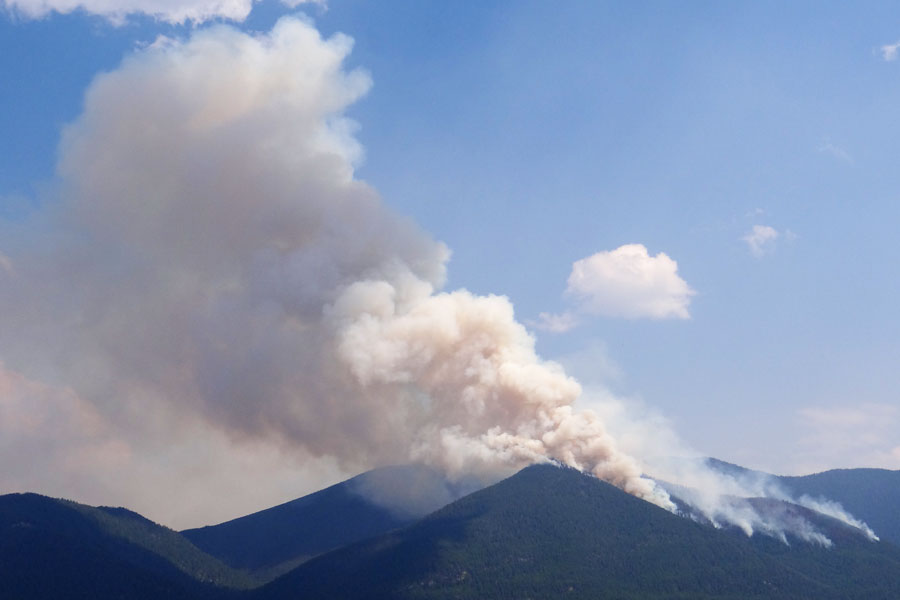Updated Aug. 14, 7:15 p.m.
Fire season is in full swing as eight major fires are burning across the region. Officials say the situation could worsen Friday as a weather system brings gusty winds and thunderstorms amid historically dry conditions.
The National Weather Service in Missoula issued a red flag warning starting at noon for the entire northern half of Montana. A cold front is moving through the area with significant lightning and some rain expected, according to forecasters. Gusty winds are predicted for the area through Saturday morning. Cooler weather and higher humidity are expected Saturday, with a return to seasonal conditions Sunday.
“If something new starts in the right spot it could be catastrophic,” said Lincoln Chute, Flathead County fire service area manager.
Chute worries that resources could be spread too thin if multiple fires take off at once. He said local firefighters have responded to 30 fires this week, although most have been contained.
—
The Thompson Fire continues to burn in the heart of Glacier National Park and remains the largest wildfire in the region. Fire managers were able to better map the blaze and have adjusted the size estimate from 15,000 acres to 13,202 acres.
The fire is burning in a remote south-central backcountry area of Glacier Park about 15 miles east of the West Glacier entrance and 12 miles southwest of the Saint Mary entrance. The fire is in the Thompson Creek and Nyack Creek drainages west of Medicine Grizzly Peak where the Flathead and Glacier Counties border follows the Continental Divide.
If weather and smoke conditions permit, two crews will fly into the backcountry area near the fire to work on control measures, according to fire managers. One crew will land near Cut Bank Pass to suppress hot spots along the fire’s edge and direct helicopter water drops. The other crew will work in the Nyack Drainage area to provide additional structure protection measures for the Upper Nyack Backcountry Patrol Cabin; cool down hot spots along the fire perimeter; direct helicopter water drops; and use pumps and hoses on any hot spots along the perimeter.
No structures have been lost or damaged. Two structures, the Upper and Lower Nyack Backcountry Patrol Cabins, have been identified as threatened. Firefighters went in this week to wrap one cabin in hopes of saving it.
A total of 104 personnel are assigned to the fire.
The fire has forced the closure of a vast swath of the park’s backcountry, including numerous trails and backcountry campgrounds in the areas of Nyack, Coal Creek, Cut Bank and Two Medicine.
The Thompson Fire is one of two major fires burning inside Glacier National Park. The Reynolds Creek Fire has burned more than 4,000 acres of land on the east side of the park since late July. It remains 67 percent contained.
The majority of Glacier National Park is unaffected by wildfire and is available for recreational use.
—
Two fires have also started east of Glacier National Park, on the Lewis & Clark National Forest and Blackfeet Indian Reservation.
The Spotted Eagle Fire has burned nearly 200 acres about 25 miles east of Essex. One helicopter is currently working the fire. Further south, near Heart Butte, the Dry Creek Fire has burned 335 acres. As of Friday morning, the Blackfeet Agency was reporting that the fire was mostly contained.
—
On the Flathead National Forest, firefighters are working to contain the 150-acre Bear Creek Fire on the Spotted Bear Ranger District, about 30 miles east of Polson. A handful of structures are threatened and there are numerous trail closures. The lightning storms that rolled across the region resulted in more than 20 different fires on the Flathead National Forest, but spokesperson Ema Braunberger said most have been less than an acre.
—
Three major fires are currently burning in Lincoln County, including the Martson Fire near Fortine. On Friday, the fire grew from 550 acres to 1,200 acres on the Kootenai National Forest. On Thursday night, when the fire first blew up, it was putting up a smoke column that could be seen in Whitefish. Kootenai National Forest Fire Manager Dan Rose said the fire is burning away from private land and that a Type II incident team will take over management of the fire this weekend. Officials will be holding a public meeting about the Marston Fire at the Trego Community Hall at 7 p.m. Friday.
Further west, the Weigel Fire has burned 100 acres about 24 miles northeast of Libby since it started on Tuesday. The fire is burning in heavy timber and smokejumpers were sent in Wednesday to try to contain it.
Because of the fire’s rapid growth, the Montana Department of Natural Resources and Conservation is bringing in a Type II incident management team to fight the fire.
East of Libby, the Dunn Fire has burned about 75 acres near Fisher River. Officials say despite its initial growth on Tuesday, the fire has slowed and is staying on a ridge top.
This story will be updated when more information becomes available.
